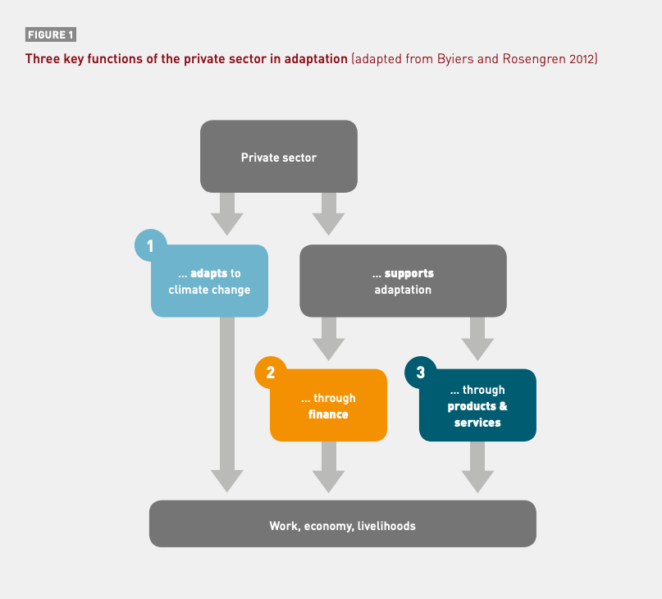The Roles of the Private Sector in Climate Change Adaptation – an Introduction

Introduction
Climate change is set to become one of the most significant – if not the most significant – challenges for economies and societies within the next decades. Adapting to its impacts will be crucial for human wellbeing.
This introduction shows that companies of any size, private associations and cooperatives, banks and investors as well as insurance companies can play three different roles in and for adaptation. They can adapt to climate change, finance climate adaptation of others and support others through products and services for resilience. The paper provides details of each of these roles and an overview of roles and activities of the private sector for adaptation, divided by type of entity.
The text below provides an overview of the paper. See the full text for more detail.
Key messages
The private sector can play three different roles in and for adaptation:
- adapt to climate change;
- finance adaptation of others; and
- support others through products and services for resilience.
By (1) adapting its own operations and assets to climate change the private sector can ensure business continuity and protect those who depend on private jobs or infrastructures. Through this, and by providing (2) funding and (3) products and services for resilience, private entities contribute to achieving the Sustainable Development Goals (SDGs) and the targets laid out in existing Nationally Determined Contributions (NDCs).

Different types of private entities can and should have different stakes in implementing, financing and supporting adaptation:
- Small-scale, local companies, entrepreneurs and farmers have to focus, first and foremost, on their own adaptation.
- Larger companies have great potential for playing all three roles – from protecting their own immediate assets to financially and otherwise supporting the wide range of stakeholders in their supply chains.
- Private associations, cooperatives and multipliers work, above all, to support the thriving of their members and stakeholders.
- Banks and investors should finance both private and public adaptation. However, adapting their portfolios to a warming world and helping clients shape more resilient projects also present crucial levers for reducing vulnerability of the financial and real economy.
- Insurance companies can finance public and private entities’ reaction to climate change but can also support them in reducing their vulnerability.
Challenges and Further Research
A growing body of literature indicates that various challenges affect how private entities approach these roles. Such publications, however, do not shed much light on the different roles that each type of private entity can play and how the challenges vary between these roles.
It should thus be considered to conduct further research in order to determine which role comes with which specific barriers and how to address them. A nuanced understanding of these challenges may be useful to develop targeted strategies for the engagement or mobilisation of different actors.
Finally, it is crucial to raise the overall ambition with which the private sector is approached and to move from theory to practice.
Suggested Citation:
Cochu, Annica; Tobias Hausotter and Mikael Henzler (2019): The Roles of the Private Sector in Climate Change Adaptation – an Introduction. Berlin: adelphi
Related resources
- Steering International Adaptation Finance Towards the Local Level
- The Roles of the Private Sector in Climate Change Adaptation - an Introduction
- Effective financing of climate adaptation measures
- Engaging the private sector in financing adaptation to climate change: Learning from practice
- Engaging the Private Sector in National Adaptation Planning Processes
- The Business Case for Responsible Corporate Adaptation: Strengthening Private Sector and Community Resilience
- Engaging the Private Sector in Green Infrastructure Development and Financing
(0) Comments
There is no content